
The Carolina parakeet, or Carolina conure, is an extinct species of small green neotropical parrot with a bright yellow head, reddish orange face, and pale beak that was native to the Eastern, Midwest, and Plains states of the United States. It was the only indigenous parrot within its range, as well as one of only three parrot species native to the United States. It was called puzzi la née or pot pot chee by the Seminole and kelinky in Chickasaw. Though formerly prevalent within its range, the bird had become rare by the middle of the 19th century. The last confirmed sighting in the wild was of the C. c. ludovicianus subspecies in 1910. The last known specimen, a male named Incas, perished in captivity at the Cincinnati Zoo in 1918, and the species was declared extinct in 1939.
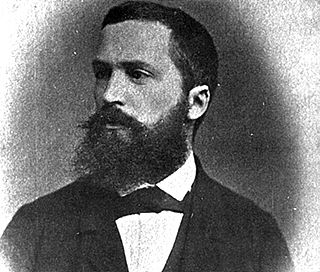
Friedrich Hermann Otto Finsch was a German ethnographer, naturalist and colonial explorer. He is known for a two-volume monograph on the parrots of the world which earned him a doctorate. He also wrote on the people of New Guinea and was involved in plans for German colonization in Southeast Asia. Several species of bird are named after him as also the town of Finschhafen in Morobe Province, Papua New Guinea and a crater on the Moon.

Christian Ludwig Brehm was a German pastor and ornithologist. He was the father of the zoologist Alfred Brehm.

The red-billed quelea, also known as the red-billed weaver or red-billed dioch, is a small—approximately 12 cm (4.7 in) long and weighing 15–26 g (0.53–0.92 oz)—migratory, sparrow-like bird of the weaver family, Ploceidae, native to Sub-Saharan Africa.
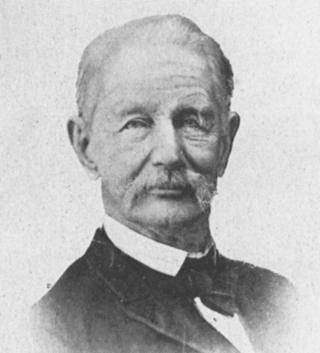
Karl Hermann Konrad Burmeister was a German Argentine zoologist, entomologist, herpetologist, botanist, and coleopterologist. He served as a professor at the University of Halle, headed the museum there and published the Handbuch der Entomologie (1832–1855) before moving to Argentina where he worked until his death.

Ernst Ludwig Krause also known under the pen-name Carus Sterne was a German pharmacist and naturalist. Sterne was noted for his popular writing on the subjects of nature, the history of science and human psychology.
Ernst M. E. Ehrenbaum was a German biologist and oceanographer.

The New Caledonian lorikeet is a potentially extinct lorikeet endemic to the Melanesian island of New Caledonia.
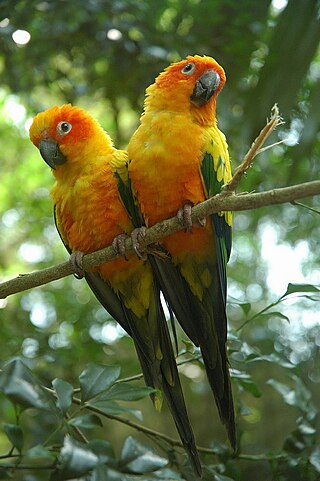
The sun conure, also known as the sun parakeet, is a medium-sized, vibrantly colored parrot native to northeastern South America. The adult male and female are similar in appearance, with black beaks, predominantly golden-yellow plumage, orange-flushed underparts and face, and green and blue-tipped wings and tails. Sun conures are very social birds, typically living in flocks. They form monogamous pairs for reproduction, and nest in palm cavities in the tropics. Sun conures mainly feed on fruits, flowers, berries, blossoms, seeds, nuts, and insects. Conures are commonly bred and kept in aviculture and may live up to 30 years. This species is currently threatened by loss of habitat and trapping for plumage or the pet trade. Sun conures are now listed as endangered by the International Union for Conservation of Nature.

Parrots (Psittaciformes), also known as psittacines, are birds with a strong curved beak, upright stance, and clawed feet. They are classified in four families that contain roughly 410 species in 101 genera, found mostly in tropical and subtropical regions. The four families are the Psittaculidae, Psittacidae, Cacatuoidea (cockatoos), and Strigopidae. One-third of all parrot species are threatened by extinction, with a higher aggregate extinction risk than any other comparable bird group. Parrots have a generally pantropical distribution with several species inhabiting temperate regions as well. The greatest diversity of parrots is in South America and Australasia.

Eugen Ferdinand von Homeyer was a German ornithologist. He made early studies of the birds of Pomerania, making collections, and was a staunch anti-Darwinian.

Adolph Eduard Grube was a German zoologist. He served as a professor at the University of Dorpat before moving to Wrocław.
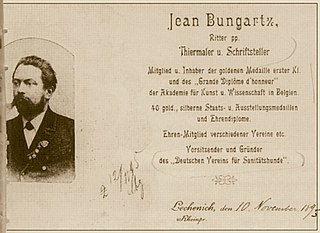
Jean Bungartz was a German animal painter, author and book illustrator.
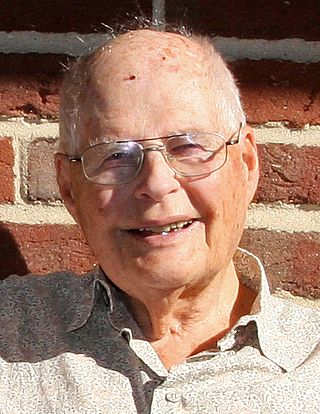
For the sexologist, psychotherapist, and social psychologist, see Gunter Schmidt.

The 1929–1930 psittacosis pandemic, also known as the psittacosis outbreak of 1929–1930 and the great parrot fever pandemic, was a series of simultaneous outbreaks of psittacosis which, accelerated by the breeding and transportation of birds in crowded containers for the purpose of trade, was initially seen to have its origin in parrots from South America. It was shortly found to have spread from several species of birds from several countries worldwide to humans between mid 1929 and early 1930. Diagnosed by its clinical features and link to birds, it affected around 750 to 800 people globally, with a mortality of 15%. Its mode of transmission to humans by mouth-to-beak contact or inhaling dried bird secretions and droppings was not known at the time. The cause, Chlamydia psittaci, which usually remains dormant in birds until activated by stress of capture and confinement, was discovered after the pandemic.

Magdalena Heinroth née Wiebe was a German ornithologist, aviculturist and taxidermist who studied numerous birds in captivity, raising them from chicks to adults. She was married to Oskar Heinroth.

Eduard Bruno Dürigen was a German science popularizer, teacher, animal keeper, herpetologist, and poultry breed specialist.
Karl Johann Nepomuk Ernst Luchs was a German physician in the Silesian spa town of Bad Warmbrunn. He was also a naturalist, aviculturist, and collector of natural history specimens. Two species of birds were named in his honour.
Ernst Karl Reich was a German businessman and aviculturist who kept nightingales and canaries at his aviary in Bremen. Along with Hans Duncker, he carried out breeding experiments on canaries. The first commercial gramophone records of bird songs included the songs of nightingales from his aviary. He had a nightingale sing into the horn of the recording equipment.

The Holy Cross Evangelical Lutheran Cemetery is a historic Lutheran burial ground in Mariendorf district of Berlin. The cemetery is owned and operated by the Evangelical Church in Berlin, Brandenburg and Silesian Upper Lusatia.

















